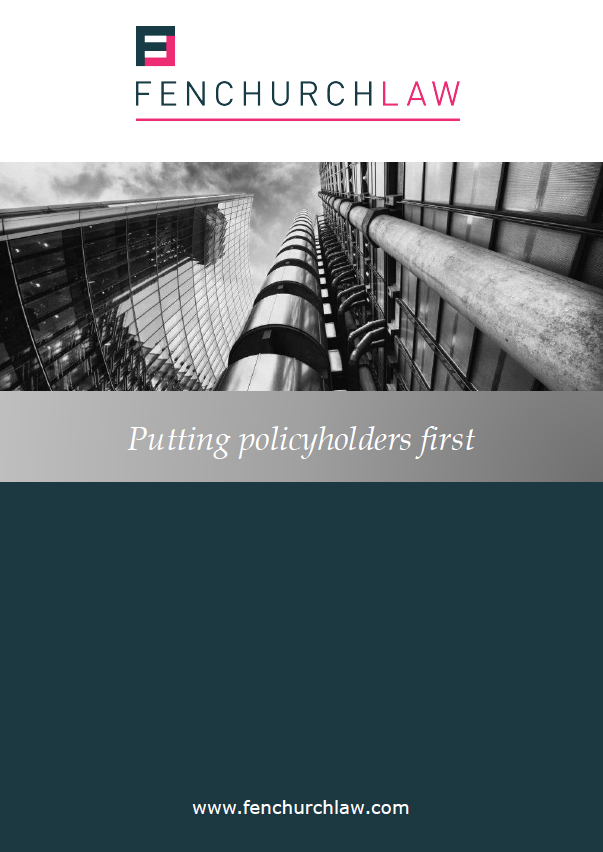
Reinstatement 101 – (rein)stating the obvious?
Reinstatement can be a difficult issue for a policyholder to navigate in the wake of a loss.
The answers to what might seem like obvious questions such as: what is it? who does it? and, do the costs actually have to be incurred? are in actual fact far from straightforward, and have been the subject matter of a number of legal cases in recent years.
This short article summarises some of the key principles that are involved.
What is it?
Reinstatement is the repair or replacement of property so that it is in the same condition or a materially equivalent condition to that which it was in prior to the loss occurring.
Of itself that seems clear enough. However, as ever the devil is in the detail, and the wording of reinstatement clauses varies from policy to policy with very different outcomes for the policyholder.
For example, depending on the precise wording, the policyholder may or may not be entitled to a cash settlement, may or may not be required to rebuild, and may or may not have to rebuild on the same site. Also, many policies give the insurer the option to reinstate.
Who does it?
As might be expected, more often than not the policyholder reinstates. However, many policies give the insurer the option to reinstate at its election. Why might an insurer choose to do so?
There are several reasons why an insurer might elect to reinstate, rather than have the policyholder reinstate or pay them an amount equivalent to the cost of reinstatement. Certainly, one reason identified by the courts is to avoid what other might be “the temptation to an ill-minded owner to set fire to the building in order to pocket the insurance money” (Reynolds v Phoenix Assurance Co Ltd [1978] 2 Lloyd’s Rep 440).
If an insurer elects to reinstate, it must give unequivocal notice to the insured, whether expressly or by conduct. Following a valid election to reinstate, the policy is no longer treated as one under which payment is to be made, and instead stands as if it had been a contract to reinstate in the first place. The consequence of this is that if the insurer fails to perform the contract adequately, it will be liable to the policyholder for damages.
Do the works have to take place?
Whether, and if so, when the reinstatement works have to be carried out, or whether the policyholder is entitled to an indemnity for what the works would cost if carried out, is again going to turn on the precise wording of the policy.
The starting position is as set out in the following extract from the judgment in Endurance Corporate Capital Ltd v Sartex Quilts & Textiles Ltd ([2020] EWCA Civ 308):
“How the claimant chooses to spend the damages and whether it actually attempts to put itself in the same position as if the breach had not occurred – for example by reinstating lost, damaged or defective property – or whether the claimant does something else with the money, is – in accordance with the general principle mentioned earlier – irrelevant to the measure of compensation.”
Therefore, subject to any contrary wording in the policy, a policyholder is entitled to recover the cost of repairing their property, regardless of whether they in fact carry out such repairs, but instead decide, for example, to sell their property or to use the money to build elsewhere on site.
Insurers often look to limit that entitlement, and reinstatement clauses often provide that the work must be commenced and carried out “with reasonable despatch”, and that “no payment is to be made until the costs of reinstatement have actually been incurred”. This presents something of a chicken and egg situation for insureds, since an impecunious policyholder will not have the funds available to pay for reinstatement without first receiving the costs of reinstatement from the insurer.
In Manchikalapati & Others v Zurich [2019] EWCA CIV 2163, the insurer contended that where the policy provided an indemnity for “the reasonable cost of rectifying or repairing damage …”, the term “reasonable cost” should be read as meaning “actual” or “incurred” costs. Therefore, because that cost had not yet been incurred, the insurer argued that its liability under the policy had not been triggered. The court rejected that argument, finding that there was nothing about the wording which indicated that the cost must be incurred before the policyholder was entitled to an indemnity.
An insurer can limit its liability to costs actually incurred, provided it uses clear language to that effect. However, absent clear language, or where the clause is neutral as to whether the cost must already be incurred or may be incurred in the future, the courts have made it clear that insurers are no longer able to able to withhold the indemnity pending the works being carried out.
To what extent are intentions relevant?
One thorny issue that has come up time and again in the context of reinstatement is the relevance of a policyholder’s intentions. This first arose in a case where the policyholder intended to sell the property at the time of the fire. In that case, the court found that the indemnity to which the policyholder was entitled was the price at which it was prepared to sell at the time of the fire. This is because a policyholder is entitled to be indemnified for its loss, and in quantifying that loss, an insured’s intentions may impact on an assessment of the value of the property to them.
This issue most recently came before the court in Endurance v Sartex [2020] EWCA Civ 308. The insured, Sartex, claimed an indemnity on the reinstatement basis following a fire at its premises. The insurers asserted that that this was inappropriate because Sartex did not have a genuine intention to reinstate, placing reliance on the fact that Sartex had not carried out reinstatement in the many years after the fire occurred. As such, the insurer said that Sartex was only entitled to the considerably lower sums representing the diminution in market value of the property as a result of the fire. The court found that the question of whether Sartex actually intended to reinstate the buildings was, in most cases, of no relevance to the measure of indemnity.
Standard of repair
Another issue that frequently arises, particularly in the context of older properties, is what happens when the reinstatement results in the property being in a condition better than it was before. This is known as betterment. The principle of betterment requires the policyholder to account to the insurer for the improved or better aspects of the new property.
Sometimes, a policyholder has no practical alternative but to replace the original property with modern, upgraded property. This is known as involuntary betterment, and in those circumstances the policyholder is entitled to the actual replacement cost.
If an insurer does look to apply a discount for betterment, a policyholder would be advised to require the insurer to identify precisely what betterment the policyholder would enjoy and to serve evidence in support, as where an insurer fails to adequality quantify and evidence its case on betterment, no deduction should be applied.
Summary
Reinstatement clauses are intended to place policyholders into a materially equivalent position to that which they would have been in had the loss not occurred. Quite how that works in practice can be a minefield, but recent case law has helpfully cleared up some misconceptions around the policyholder’s intentions and the extent to which the works have to be carried out – both of which will be of assistance to policyholders in getting their claims paid.
Alex Rosenfield is a Senior Associate at Fenchurch Law
Other news
Fenchurch Law expands into Scandinavia with Denmark office launch
31 October 2024
Fenchurch Law, the award winning international law firm working exclusively for insurance policyholders and brokers,…



